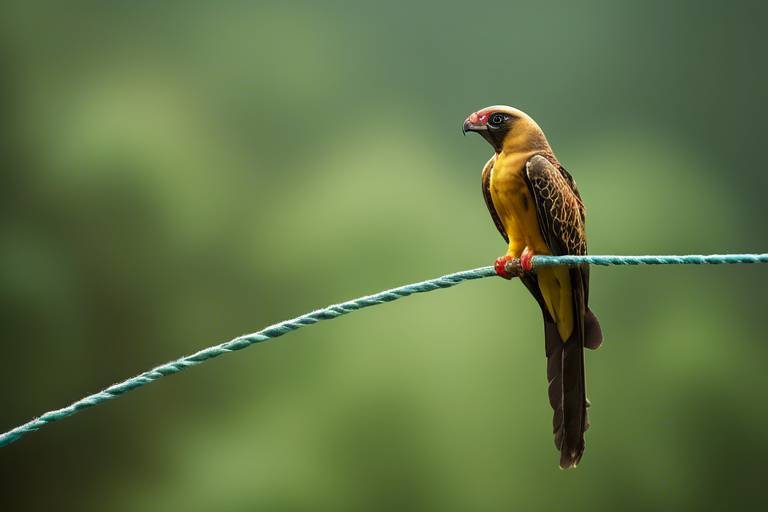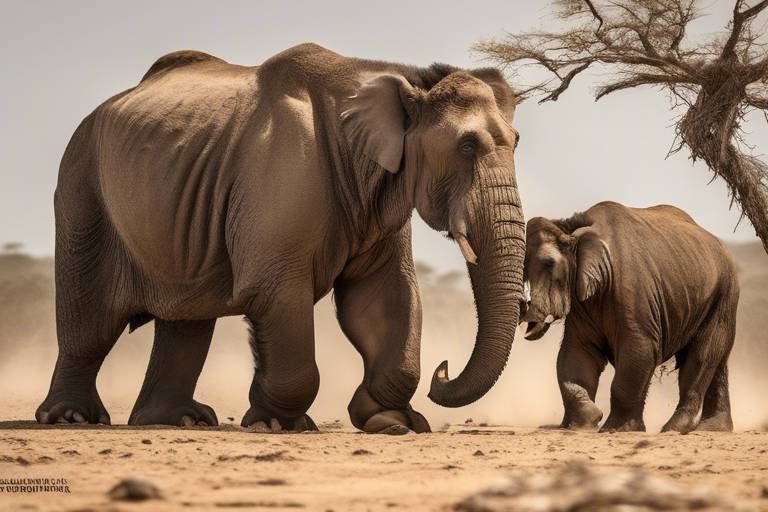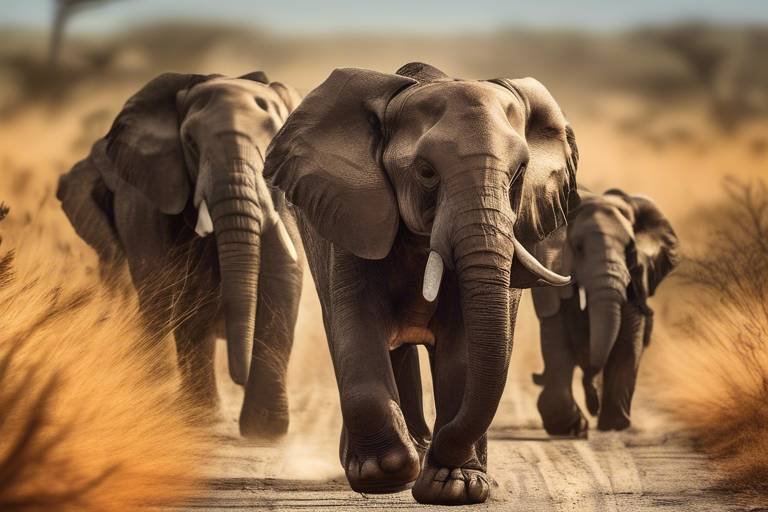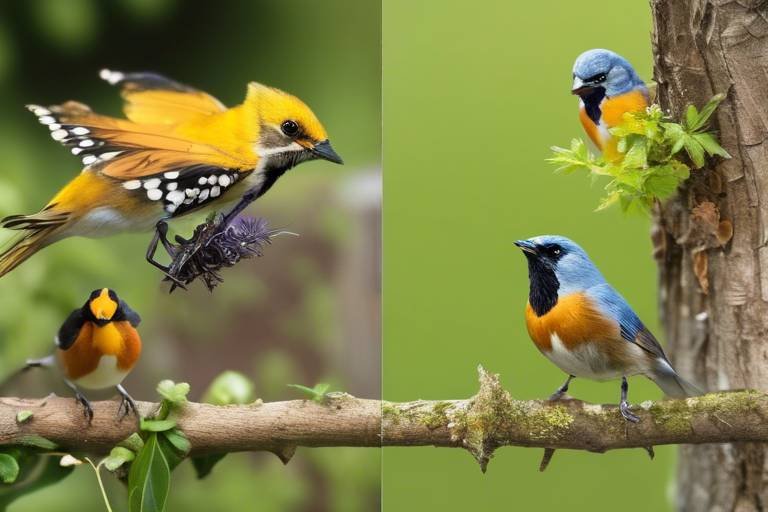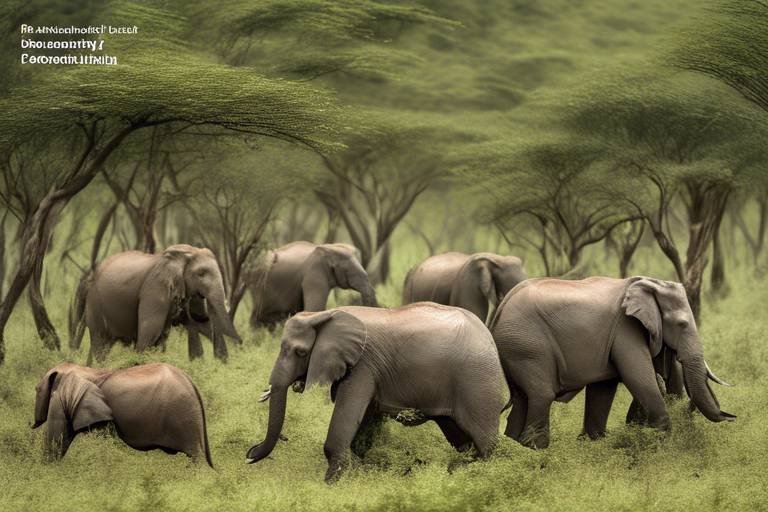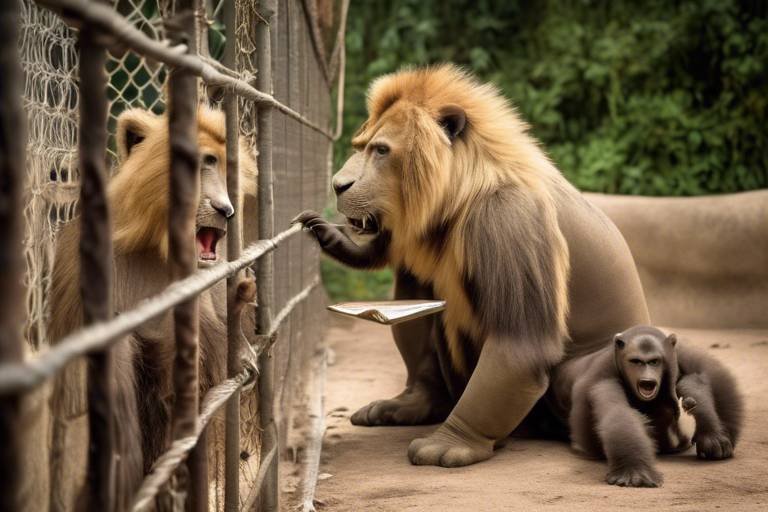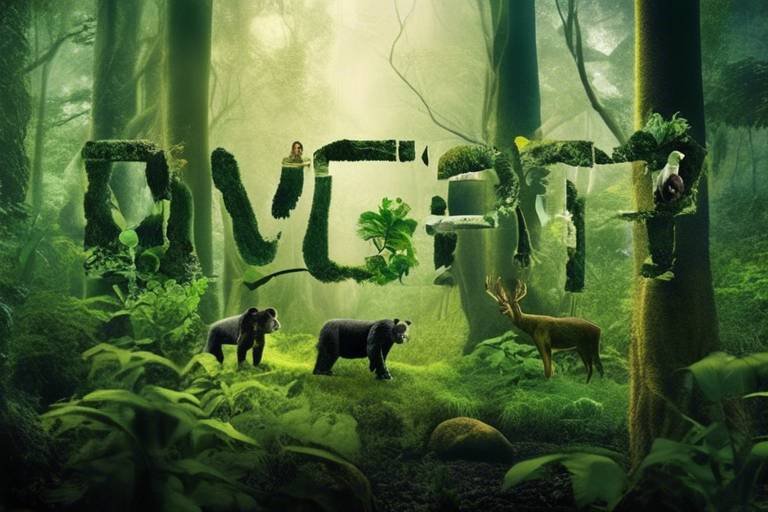Balancing On A Tightrope: Biodiversity And Sustainable Development
In a world that often seems to prioritize short-term gains over long-term sustainability, the delicate balance between biodiversity and sustainable development has become a tightrope act that we must all navigate. Imagine walking a tightrope strung high above a bustling city; one misstep could lead to disaster. Similarly, our approach to development must be carefully calibrated to ensure that we do not lose sight of the ecological treasures that support life on Earth. This article delves into the intricate relationship between biodiversity and sustainable development, emphasizing the importance of maintaining ecological balance while pursuing economic growth and social equity.
Biodiversity is not just a buzzword; it is the foundation of our ecosystems. Think of it as the intricate web of life where each strand is essential. From the tiniest microorganisms to the largest mammals, every organism plays a role in maintaining ecosystem functionality. These living systems provide us with essential services, such as pollination, which is crucial for food production, water purification, which ensures clean drinking water, and climate regulation, which helps stabilize our environment. Without these services, our survival and well-being would be at risk. In fact, studies show that a decline in biodiversity can lead to a ripple effect, causing disruptions that affect everything from our food supply to our health.
The United Nations has recognized the urgency of these challenges through the establishment of the Sustainable Development Goals (SDGs). These 17 goals aim to address global issues, including those related to biodiversity, by promoting inclusive economic growth, social inclusion, and environmental sustainability. It's like having a roadmap that guides us toward a future where people and nature can thrive together. However, achieving these goals requires a concerted effort from governments, businesses, and communities alike.
To truly embrace sustainable development, effective policies must incorporate biodiversity considerations. This means that development projects should not compromise ecological integrity. Imagine planning a new shopping mall in a vibrant forest; without proper consideration, we could destroy habitats that are home to countless species. Policymakers need to promote sustainable land and resource management practices that recognize the value of biodiversity. By integrating these principles into legislation, we can ensure that economic development does not come at the expense of our planet’s health.
Examining successful case studies reveals how various regions have effectively integrated biodiversity into their development plans. For instance, in Costa Rica, the government has implemented payment for ecosystem services programs that incentivize landowners to preserve their forests. This approach not only protects biodiversity but also enhances local economies through eco-tourism and sustainable agriculture. Such examples serve as a beacon of hope, demonstrating that it is possible to achieve improved environmental outcomes while reaping economic benefits.
Despite the importance of integrating biodiversity into policy, numerous challenges can hinder effective implementation. Issues such as a lack of political will, inadequate funding, and limited public awareness can create significant roadblocks. It's like trying to build a bridge with missing pieces; without the right support, the structure will inevitably fail. To overcome these challenges, it is crucial for stakeholders to collaborate and raise awareness about the importance of biodiversity in achieving sustainable development.
One of the most effective ways to promote biodiversity is through community involvement in conservation efforts. When local communities are engaged, they become stewards of their environment, fostering sustainable practices that align with their needs and values. Imagine a neighborhood coming together to clean up a local river; not only does this improve the ecosystem, but it also strengthens community bonds. Engaging communities ensures that development initiatives are not just top-down mandates but rather collaborative efforts that resonate with those most affected.
The loss of biodiversity can have significant economic repercussions. Industries such as agriculture, fisheries, and tourism heavily rely on healthy ecosystems. For example, a decline in bee populations can directly affect crop yields, leading to increased food prices and economic instability. It is essential to consider ecological health in economic planning; otherwise, we risk jeopardizing our livelihoods. The old saying "you don't know what you've got until it's gone" rings particularly true in this context.
Quantifying the economic value of ecosystem services can help decision-makers understand the financial benefits of preserving biodiversity. By putting a price tag on services like water filtration or carbon sequestration, we can make a compelling case for conservation. This economic perspective can lead to more informed and sustainable development choices, ensuring that we prioritize the health of our planet while pursuing growth.
Investing in green technologies and sustainable practices is another critical strategy to mitigate biodiversity loss. Think of it as planting seeds for a future where both the environment and society can flourish. Technologies that promote renewable energy, waste reduction, and resource efficiency not only help protect biodiversity but also create jobs and stimulate economic growth. It's a win-win scenario that demonstrates that sustainability and economic progress can go hand in hand.
- What is biodiversity? Biodiversity refers to the variety of life on Earth, including the diversity of species, ecosystems, and genetic variations.
- Why is biodiversity important for sustainable development? Biodiversity supports ecosystem services that are essential for human survival, such as clean air, water, and food production.
- How can communities get involved in conservation? Communities can participate through local conservation programs, education initiatives, and sustainable practices that protect their environment.
- What are the economic impacts of biodiversity loss? Biodiversity loss can lead to decreased productivity in industries like agriculture and tourism, ultimately affecting economic stability.
- How can investments in green technology help? Investments in green technologies promote sustainable practices that protect biodiversity while fostering economic growth and job creation.

The Importance of Biodiversity
Biodiversity is not just a fancy word thrown around in environmental discussions; it’s the lifeblood of our planet, the intricate web that supports all forms of life. Imagine a world where every species, from the tiniest insect to the largest mammal, plays a unique role in maintaining the balance of our ecosystems. Each organism contributes to a complex puzzle, and when one piece is removed, the entire picture can fall apart. The importance of biodiversity cannot be overstated, as it provides essential services that are vital for human survival and well-being.
Think about the last time you enjoyed a delicious meal. Chances are, many of the ingredients came from plants and animals that thrive in diverse ecosystems. Pollination, for instance, is a critical service provided by a variety of species, including bees, birds, and bats. Without these pollinators, our food supply would dwindle, leading to higher prices and less variety on our plates. In fact, it’s estimated that one-third of the food we consume relies on pollination. Isn’t it fascinating how interconnected we are with nature?
Moreover, biodiversity plays a crucial role in water purification and climate regulation. Wetlands, forests, and grasslands work tirelessly to filter pollutants from water, ensuring that we have clean drinking water. These ecosystems also act as carbon sinks, absorbing carbon dioxide from the atmosphere and helping to mitigate climate change. When we lose biodiversity, we not only jeopardize these natural processes but also expose ourselves to greater risks of environmental disasters.
To illustrate the importance of biodiversity, let’s take a look at some of the key ecosystem services it provides:
| Service | Description | Examples |
|---|---|---|
| Pollination | Transfer of pollen from male to female parts of flowers, enabling fruit and seed production. | Bees, butterflies, hummingbirds |
| Water Purification | Natural filtration of water through wetlands and other ecosystems. | Wetlands, forests |
| Climate Regulation | Absorption of greenhouse gases and regulation of local climates. | Forests, oceans |
| Soil Fertility | Maintaining soil health through diverse microbial communities. | Earthworms, fungi |
As we can see, biodiversity is essential for maintaining the health of our planet. It’s not just about saving cute animals and beautiful plants; it’s about ensuring our own survival and quality of life. However, human activities, such as deforestation, pollution, and overfishing, are putting immense pressure on our natural ecosystems. The loss of biodiversity can lead to a cascade of negative effects, not only for the environment but also for our economies and communities.
In conclusion, recognizing and appreciating the importance of biodiversity is the first step towards fostering a sustainable future. It’s about understanding that every species, no matter how small, has a role to play in keeping our planet healthy. By protecting biodiversity, we are ultimately protecting ourselves and future generations. So, let’s make a conscious effort to support conservation initiatives and sustainable practices in our daily lives. After all, we are all part of this beautiful tapestry of life, and it’s our responsibility to keep it intact.
- What is biodiversity? Biodiversity refers to the variety of life on Earth, including the diversity of species, ecosystems, and genetic variations.
- Why is biodiversity important? Biodiversity is crucial for ecosystem functionality, providing essential services like pollination, water purification, and climate regulation.
- How does human activity impact biodiversity? Human activities such as deforestation, pollution, and overexploitation of resources contribute to habitat loss and species extinction.
- What can I do to help protect biodiversity? You can support conservation efforts, reduce waste, use sustainable products, and educate others about the importance of biodiversity.

Sustainable Development Goals (SDGs)
The are a universal call to action established by the United Nations in 2015, aiming to address the world's most pressing challenges by 2030. These 17 goals are interconnected and encompass a broad range of social, economic, and environmental issues. But what does this mean for biodiversity? Well, the SDGs are not just about growth; they emphasize the need for a holistic approach that considers ecological balance as a fundamental component of sustainable development.
One of the core principles behind the SDGs is the recognition that economic growth must not come at the expense of the environment. For instance, Goal 15 explicitly aims to protect, restore, and promote sustainable use of terrestrial ecosystems, sustainably manage forests, combat desertification, and halt and reverse land degradation and halt biodiversity loss. This goal is crucial because it directly addresses the alarming rates of species extinction and habitat destruction that threaten the very foundation of our ecosystems.
Moreover, the SDGs encourage nations to adopt policies that foster inclusive economic growth while ensuring that marginalized communities are not left behind. This aspect is vital for biodiversity because local communities often serve as stewards of their natural environments. When they are included in the planning and decision-making processes, their traditional knowledge and practices can contribute significantly to conservation efforts. For example, sustainable fishing practices can be developed with input from local fishers, ensuring both economic viability and the health of marine ecosystems.
To illustrate the impact of the SDGs on biodiversity, let’s take a closer look at some of the goals that directly relate to environmental sustainability:
| Goal | Description |
|---|---|
| Goal 13 | Take urgent action to combat climate change and its impacts. |
| Goal 14 | Conserve and sustainably use the oceans, seas, and marine resources for sustainable development. |
| Goal 15 | Protect, restore, and promote sustainable use of terrestrial ecosystems, sustainably manage forests, combat desertification, and halt biodiversity loss. |
These goals are not standalone; they intersect and overlap in ways that can amplify their effectiveness. For instance, achieving Goal 14 on marine conservation can also help meet Goal 1, which aims to end poverty in all its forms everywhere, by ensuring that communities relying on fishing for their livelihoods can continue to thrive. This interconnectedness is a reminder that biodiversity is not just a luxury; it is a necessity for human survival and economic stability.
However, the path to achieving these goals is fraught with challenges. Many countries struggle with limited resources, political instability, and a lack of public awareness about the importance of biodiversity. Effective communication and education are essential to overcome these hurdles. By raising awareness about the benefits of biodiversity, we can inspire action at all levels—from local communities to international organizations.
In conclusion, the Sustainable Development Goals provide a comprehensive framework that not only addresses economic growth and social equity but also emphasizes the critical role of biodiversity in achieving a sustainable future. As we work towards these goals, it is imperative to recognize that our planet's health is intricately linked to our own well-being. The time to act is now, and by integrating biodiversity into our development strategies, we can pave the way for a more sustainable and equitable world.
- What are the Sustainable Development Goals?
The SDGs are 17 interconnected global goals designed to be a "blueprint to achieve a better and more sustainable future for all" by 2030. - How do the SDGs relate to biodiversity?
Several SDGs directly address environmental sustainability, aiming to protect ecosystems and biodiversity as part of sustainable development. - Why is community involvement important in achieving the SDGs?
Engaging local communities ensures that development initiatives are aligned with their needs, leveraging their traditional knowledge for effective conservation.

Integrating Biodiversity into Policy
Integrating biodiversity into policy is not just a lofty ideal; it's a necessity for ensuring a sustainable future. Imagine a world where economic development and environmental health coexist harmoniously. Sounds dreamy, right? But achieving this balance requires deliberate actions and thoughtful policies. It's essential to recognize that biodiversity is not merely a collection of species, but a complex web of life that supports our ecosystems and, ultimately, our own existence. Policies that neglect this vital relationship risk jeopardizing both our natural resources and our economic viability.
To effectively integrate biodiversity into policy, decision-makers must consider several key factors. First and foremost, stakeholder engagement is crucial. This means involving not only government officials but also local communities, businesses, and environmental organizations in the decision-making process. When people feel their voices are heard, they are more likely to support and adhere to policies that promote biodiversity. Additionally, policies should be backed by scientific research, providing a solid foundation for understanding the ecological implications of development activities.
Moreover, the implementation of environmental assessments is vital. These assessments help identify potential impacts on biodiversity before a project begins, allowing for adjustments that can minimize harm. For instance, consider a proposed construction project in a sensitive area. Without an environmental assessment, the project could lead to habitat destruction and loss of species, ultimately costing more in the long run due to ecosystem degradation. By integrating biodiversity considerations from the outset, we can create a framework that not only protects the environment but also enhances the resilience of local economies.
Here's a quick look at some effective strategies for integrating biodiversity into policy:
- Cross-sectoral collaboration: Encourage cooperation among various sectors such as agriculture, forestry, and urban planning to create cohesive strategies.
- Incentives for sustainable practices: Implement financial incentives for businesses and communities that adopt biodiversity-friendly practices.
- Education and awareness: Promote public awareness campaigns that highlight the importance of biodiversity and its role in sustainable development.
As we move forward, it's essential to recognize the challenges that come with integrating biodiversity into policy. There may be resistance from industries that prioritize short-term gains over long-term sustainability. Additionally, the lack of funding for biodiversity initiatives can hinder progress. However, by fostering a culture of collaboration and understanding the intrinsic value of biodiversity, we can overcome these obstacles. The journey toward sustainable development is akin to walking a tightrope; it requires balance, focus, and commitment to ensure that we do not fall off into the abyss of environmental degradation.
Q: Why is biodiversity important for sustainable development?
A: Biodiversity is essential for ecosystem functionality, providing vital services such as pollination, water purification, and climate regulation, all of which support human life and well-being.
Q: How can local communities contribute to biodiversity conservation?
A: Engaging local communities in conservation efforts fosters stewardship and ensures that development initiatives align with the needs and values of those most affected.
Q: What are some challenges in integrating biodiversity into policy?
A: Challenges include political will, funding limitations, and public awareness, which can hinder effective implementation and enforcement of biodiversity-friendly policies.
Q: How can businesses benefit from integrating biodiversity into their practices?
A: Businesses that adopt sustainable practices can enhance their reputation, reduce operational risks, and potentially lower costs through efficiency and resource conservation.

Case Studies of Successful Integration
Examining successful case studies reveals the transformative power of integrating biodiversity into development plans. One notable example comes from the Amazon Rainforest, where local communities have taken the reins in sustainable management practices. By adopting agroforestry techniques, these communities have managed to balance agricultural production with the conservation of native species. This approach not only preserves the rich biodiversity of the region but also enhances food security and economic resilience for the local population.
Another compelling case is found in Costa Rica, a country renowned for its commitment to environmental conservation. Through a series of innovative policies, Costa Rica has successfully integrated biodiversity into its national development strategy. The government established a payment for ecosystem services (PES) program, which incentivizes landowners to maintain forest cover and protect biodiversity. As a result, forest cover has increased from 21% in the 1980s to over 50% today, showcasing how economic incentives can lead to significant ecological benefits.
In Rwanda, the integration of biodiversity into tourism has proven to be a lucrative and sustainable model. The country has developed eco-tourism initiatives that not only attract visitors but also fund conservation efforts. For instance, the revenue generated from gorilla trekking in the Volcanoes National Park supports local communities and conservation projects. This symbiotic relationship highlights how economic growth can align with environmental stewardship, creating a win-win scenario for both nature and society.
These case studies illustrate that when biodiversity is prioritized in planning and policy-making, the results can be profound. However, it’s essential to recognize that successful integration requires ongoing commitment and collaboration among various stakeholders. Whether it’s governments, local communities, or private sectors, a united effort is crucial to ensure that biodiversity remains at the forefront of sustainable development.
- What is biodiversity, and why is it important? Biodiversity refers to the variety of life on Earth, including the diversity of species, ecosystems, and genetic variations. It is crucial for ecosystem functionality, providing essential services such as pollination, water purification, and climate regulation.
- How can communities get involved in biodiversity conservation? Communities can engage in conservation by participating in local initiatives, adopting sustainable practices, and collaborating with organizations focused on environmental protection.
- What are some economic benefits of preserving biodiversity? Preserving biodiversity can enhance industries such as agriculture, fisheries, and tourism, leading to improved economic stability and growth.
- How does sustainable development relate to biodiversity? Sustainable development aims to balance economic growth, social inclusion, and environmental protection, ensuring that biodiversity is maintained for future generations.

Challenges in Policy Implementation
Implementing policies that effectively integrate biodiversity considerations is no walk in the park. It's more like trying to juggle flaming torches while riding a unicycle! The challenges are multifaceted and can often feel overwhelming. One of the most pressing issues is the lack of political will. Even when the importance of biodiversity is acknowledged, it often takes a backseat to more immediate economic concerns. Politicians may prioritize short-term gains over long-term ecological health, leading to policies that neglect the very ecosystems we rely on.
Another significant hurdle is funding. Developing and implementing policies that protect biodiversity requires substantial financial resources. Unfortunately, many governments and organizations struggle to allocate sufficient funds for conservation efforts. This can result in poorly designed initiatives that fail to achieve their intended outcomes. For instance, when budgets are tight, conservation projects may be cut or scaled back, diminishing their effectiveness and leaving vulnerable ecosystems at risk.
Public awareness and engagement also play a crucial role in policy implementation. Many people are simply unaware of the importance of biodiversity and the direct impact it has on their lives. This lack of understanding can lead to resistance against conservation measures. If communities do not see the value in protecting their local ecosystems, they are less likely to support policies aimed at doing so. Therefore, raising awareness about the benefits of biodiversity is essential for garnering public support and ensuring successful policy implementation.
Moreover, the complexity of ecosystems can make it difficult to create effective policies. Biodiversity is not just about the number of species; it's about the intricate relationships between them and their environments. This complexity can lead to misinterpretation of data and ineffective measures. Policymakers may struggle to understand the nuances of ecological interdependence, resulting in oversimplified solutions that fail to address the root causes of biodiversity loss.
Additionally, there are often competing interests at play. For example, agricultural expansion, urban development, and industrial growth can conflict with biodiversity conservation efforts. This tug-of-war can create a situation where policies are watered down or compromised, ultimately undermining their effectiveness. To navigate these challenges, it is essential to foster collaboration among stakeholders, including governments, businesses, and local communities.
In summary, the challenges in implementing policies that integrate biodiversity considerations are numerous and complex. From political will and funding issues to public awareness and the intricacies of ecosystems, each factor plays a significant role in either facilitating or hindering effective policy development. Addressing these challenges requires a concerted effort from all sectors of society, emphasizing the need for collaboration and understanding.
- What is biodiversity? Biodiversity refers to the variety of life on Earth, including the diversity of species, ecosystems, and genetic variations within species.
- Why is biodiversity important? Biodiversity is essential for ecosystem functionality, providing vital services such as pollination, climate regulation, and water purification, which are crucial for human survival.
- What are the main challenges in conserving biodiversity? Key challenges include political will, funding limitations, public awareness, and competing interests in land use.
- How can communities contribute to biodiversity conservation? Local communities can engage in conservation efforts by participating in sustainable practices, supporting policies that protect ecosystems, and raising awareness about biodiversity's importance.

Community Involvement in Conservation
Community involvement in conservation is not just a buzzword; it’s a critical ingredient for successful environmental management. When local communities take an active role in conservation efforts, they not only help protect their natural surroundings but also enhance their own livelihoods. Imagine a community that relies on a nearby forest for resources. If they are engaged in its conservation, they’re more likely to see the benefits—cleaner water, richer biodiversity, and even sustainable tourism opportunities. It’s a win-win situation!
One of the most effective ways to foster community involvement is through education and awareness programs. By informing community members about the importance of biodiversity and the role they can play, we empower them to take action. For instance, workshops that teach sustainable farming practices or the significance of local flora and fauna can spark a sense of ownership. When people understand the direct impact of their actions on the environment, they are more inclined to participate in conservation efforts.
Moreover, forming partnerships between local communities and conservation organizations can significantly amplify these efforts. These collaborations can lead to initiatives that are tailored to the specific needs and values of the community. For example, a project that combines traditional knowledge with scientific research can uncover innovative solutions to conservation challenges. This synergy not only enhances the effectiveness of conservation strategies but also builds trust and respect between stakeholders.
Involving communities in decision-making processes is also essential. When people feel their voices are heard, they are more likely to support conservation measures. This can be achieved through community meetings or forums where individuals can express their concerns and suggestions. By creating a platform for dialogue, we can ensure that conservation strategies are not only effective but also culturally relevant.
To illustrate the impact of community involvement, let’s look at a few successful case studies:
| Project | Location | Outcome |
|---|---|---|
| Community Forest Management | Nepal | Increased forest cover and improved livelihoods |
| Marine Protected Areas | Philippines | Restored fish populations and enhanced local fisheries |
| Wildlife Conservation Programs | Tanzania | Reduced poaching and boosted eco-tourism |
These examples showcase how community involvement can lead to tangible benefits for both the environment and local economies. However, it’s important to recognize that challenges still exist. Factors such as lack of funding, political instability, and varying levels of education can hinder community engagement. Addressing these challenges requires a concerted effort from governments, NGOs, and the communities themselves to create an enabling environment for conservation.
Ultimately, the path to sustainable development is paved with the active participation of local communities. By embracing their role as stewards of the environment, communities can help ensure that conservation efforts are not only effective but also sustainable in the long run. So, let’s ask ourselves: how can we further empower these communities to take charge of their natural resources? The answer lies in collaboration, education, and respect for local knowledge.
- Why is community involvement important in conservation? Community involvement ensures that conservation efforts are relevant, culturally appropriate, and effective in addressing local needs.
- How can communities participate in conservation? Communities can engage in conservation through education programs, partnerships with NGOs, and participation in decision-making processes.
- What are some successful examples of community-led conservation? Examples include community forest management in Nepal and marine protected areas in the Philippines.

Economic Implications of Biodiversity Loss
The loss of biodiversity isn't just an environmental issue; it's a ticking time bomb for our economies. Imagine a world where the vibrant colors of nature fade, where the hum of bees and the rustle of leaves become distant memories. This scenario isn't just poetic; it's a stark reality that could unfold if we don't take action. Biodiversity is a cornerstone of our economy, providing essential resources and services that we often take for granted. From agriculture to tourism, the economic implications of biodiversity loss are profound and far-reaching.
Let's break it down. When we talk about biodiversity, we're referring to the variety of life forms on Earth, including plants, animals, and microorganisms. Each of these species plays a unique role in maintaining the balance of ecosystems, which in turn supports human life and economic activity. For instance, healthy ecosystems are crucial for pollination, which directly affects our food supply. Without bees and other pollinators, many crops would fail, leading to higher food prices and potential shortages. The economic impact of such a collapse could be catastrophic, affecting not just farmers but also consumers worldwide.
Moreover, industries like fisheries rely heavily on biodiversity. Overfishing, habitat destruction, and pollution are already taking their toll on fish populations. As these resources dwindle, the livelihoods of countless fishermen and their families are jeopardized. The ripple effect extends to the global market, where fish is a staple food source for millions. According to the Food and Agriculture Organization (FAO), approximately 3 billion people depend on fish as their primary source of protein. Losing biodiversity in marine ecosystems could lead to a significant food security crisis.
Tourism is another sector that suffers from biodiversity loss. Think about it: what draws tourists to a destination? It's often the unique flora and fauna, the stunning landscapes, and the rich ecosystems. When these are compromised, so too is the economic vitality of regions that depend on tourism. A report by the United Nations Environment Programme (UNEP) indicates that biodiversity loss could reduce global tourism revenues by billions of dollars annually. This loss not only affects businesses but also the communities that rely on tourism for their economic survival.
Now, you might wonder, how do we quantify the economic value of biodiversity? One effective way is through the concept of ecosystem services. These are the benefits that humans derive from nature, such as clean air, water filtration, and climate regulation. A study published in the journal Nature estimates that the global value of ecosystem services is over $125 trillion per year. Yet, we often overlook these services in economic planning. By failing to account for the value of biodiversity, we risk making decisions that could lead to irreversible damage.
To put it in perspective, consider the following table that illustrates the economic contributions of various ecosystems:
| Ecosystem Type | Annual Economic Value (in Trillions) | Key Services Provided |
|---|---|---|
| Forests | $2.2 | Carbon storage, timber production, recreation |
| Wetlands | $1.7 | Water filtration, flood protection, habitat for wildlife |
| Coral Reefs | $0.3 | Coastal protection, tourism, fisheries |
| Grasslands | $1.0 | Grazing, carbon storage, biodiversity |
As we can see, the economic implications of biodiversity loss are not just theoretical; they are very real and measurable. It’s crucial for policymakers and businesses to recognize that investing in biodiversity is not merely an environmental concern but a smart economic strategy. By valuing and protecting our natural resources, we can ensure a sustainable future for both our planet and our economies.
In conclusion, the loss of biodiversity poses significant risks to economic stability and growth. It's time to shift our perspective and understand that a healthy environment is synonymous with a healthy economy. As stewards of the planet, we must take action to protect biodiversity, ensuring that future generations can thrive in a world rich in life and opportunity.
- What is biodiversity? Biodiversity refers to the variety of life forms on Earth, including different species of plants, animals, and microorganisms.
- How does biodiversity loss affect the economy? Biodiversity loss can lead to decreased food security, loss of livelihoods in sectors like fisheries and tourism, and diminished ecosystem services that are vital for economic stability.
- What are ecosystem services? Ecosystem services are the benefits that humans obtain from ecosystems, including clean air, water purification, pollination, and climate regulation.
- How can we protect biodiversity? Protecting biodiversity requires sustainable practices, conservation efforts, and policies that integrate ecological considerations into economic planning.

Valuing Ecosystem Services
Understanding the value of ecosystem services is like discovering a hidden treasure chest in the heart of nature. These services, which include pollination, water purification, and climate regulation, are essential for our survival and well-being. Yet, they often go unnoticed and unappreciated in economic planning. Imagine a world without bees—our crops would suffer, and food prices would skyrocket. This analogy highlights the critical role that biodiversity plays in maintaining these services. By placing a monetary value on ecosystem services, we can better appreciate their significance and advocate for their preservation.
To effectively convey the importance of these services, researchers have developed methods to quantify their economic value. This involves assessing the benefits provided by ecosystems and translating them into financial terms. For example, a study might estimate the annual value of wetlands in terms of flood protection and water filtration. When decision-makers have access to these figures, they can make more informed choices that prioritize ecological health alongside economic growth.
Here’s a breakdown of some key ecosystem services and their estimated values:
| Ecosystem Service | Estimated Annual Value (USD) |
|---|---|
| Pollination | $200 billion |
| Water Regulation | $500 billion |
| Climate Regulation | $1.5 trillion |
| Soil Fertility | $200 billion |
These figures illustrate just how vital it is to incorporate ecosystem service valuations into our economic frameworks. When we recognize that nature is not simply a backdrop to our lives but rather a partner in our survival, we can begin to shift our policies and practices towards sustainability. It’s a win-win scenario: protecting biodiversity not only safeguards our environment but also supports economic stability.
However, valuing ecosystem services is not without its challenges. There are complexities in accurately measuring these services and the interdependencies among them. For instance, the decline of one species can have a ripple effect on others, leading to a loss of overall ecosystem functionality. Therefore, it is crucial to adopt a holistic approach when assessing these values, considering the intricate web of life that sustains us.
In conclusion, recognizing and valuing ecosystem services is a critical step towards fostering a sustainable future. By integrating these values into our economic planning, we can ensure that our development efforts do not come at the expense of the very systems that support life on Earth. It's time to give nature its due respect and acknowledge that a healthy environment is the foundation of a thriving economy.
- What are ecosystem services? Ecosystem services are the benefits that humans receive from nature, including clean air, water, pollination, and climate regulation.
- Why is it important to value ecosystem services? Valuing ecosystem services helps us understand their economic significance, which can lead to better decision-making and policies that protect the environment.
- How can ecosystem services be measured? Ecosystem services can be measured using various methods, including market prices, contingent valuation, and cost-benefit analysis.
- What role does biodiversity play in ecosystem services? Biodiversity is essential for maintaining the resilience and functionality of ecosystems, which in turn supports the delivery of ecosystem services.

Investment in Green Technologies
Investing in green technologies is not just a trend; it’s a necessity for our planet's future. As we face the pressing challenges of climate change and biodiversity loss, the need for sustainable solutions becomes more urgent than ever. Green technologies, which encompass a wide array of innovations aimed at reducing environmental impact, can play a pivotal role in achieving both ecological balance and economic growth. Imagine a world where our energy comes from the sun, our buildings are self-sustaining, and our waste is minimized. This isn’t just a dream; it’s a reality we can create through smart investments.
One of the most compelling reasons to invest in green technologies is their potential to mitigate biodiversity loss. For instance, renewable energy sources like solar and wind power reduce our reliance on fossil fuels, which are notorious for their detrimental effects on ecosystems. By transitioning to cleaner energy, we not only cut down greenhouse gas emissions but also protect habitats from the ravages of oil spills and mining activities. Additionally, innovations in sustainable agriculture, such as precision farming and organic practices, can help maintain soil health and promote biodiversity. These methods ensure that we can produce food without sacrificing the ecosystems that support us.
Moreover, the economic benefits of investing in green technologies are substantial. A report by the International Renewable Energy Agency (IRENA) shows that the renewable energy sector alone could create millions of jobs globally. In fact, the growth of green jobs is outpacing that of traditional sectors. Here’s a quick breakdown of potential job growth in various green technology sectors:
| Sector | Estimated Job Growth (2020-2030) |
|---|---|
| Solar Energy | 400,000+ |
| Wind Energy | 300,000+ |
| Energy Efficiency | 200,000+ |
| Sustainable Agriculture | 150,000+ |
This table illustrates just a fraction of the potential job opportunities that can arise from a shift towards sustainable practices. By directing funds into these technologies, we not only foster innovation but also create a resilient economy that can withstand the fluctuations of the global market. Think of it as planting seeds for a greener future—each investment is a step towards a more sustainable and prosperous world.
However, it’s important to note that the transition to green technologies isn’t without its challenges. Initial investment costs can be high, and there may be a lack of infrastructure in certain regions. But the long-term benefits far outweigh these hurdles. Governments, businesses, and individuals must collaborate to create a supportive environment for these technologies to thrive. This can include offering tax incentives for green investments, funding research and development, and promoting public awareness about the importance of sustainability.
In conclusion, the investment in green technologies is a crucial step towards preserving biodiversity while fostering economic growth. It’s about creating a symbiotic relationship between our planet and its inhabitants. By embracing these innovations, we can ensure a healthier environment for future generations, proving that sustainability and prosperity can go hand in hand. So, are you ready to invest in a greener tomorrow?
- What are green technologies? Green technologies refer to innovations that aim to reduce environmental impacts, including renewable energy sources, sustainable agriculture practices, and energy-efficient systems.
- How do green technologies help biodiversity? By reducing pollution, conserving resources, and promoting sustainable practices, green technologies help protect ecosystems and the species that inhabit them.
- What are some examples of green technologies? Examples include solar panels, wind turbines, electric vehicles, and organic farming practices.
- Can investing in green technologies be profitable? Yes, investing in green technologies can lead to job creation, cost savings in energy, and long-term economic growth.
Frequently Asked Questions
- What is biodiversity and why is it important?
Biodiversity refers to the variety of life on Earth, including the different species of plants, animals, and microorganisms, as well as the ecosystems they form. It's crucial because it ensures ecosystem resilience, providing essential services like pollination, water purification, and climate regulation, all of which are vital for human survival and well-being.
- How do Sustainable Development Goals (SDGs) relate to biodiversity?
The Sustainable Development Goals (SDGs) set by the United Nations aim to tackle global challenges, including those tied to biodiversity. They promote inclusive economic growth, social equity, and environmental sustainability, recognizing that healthy ecosystems are fundamental to achieving these goals.
- What are some successful examples of integrating biodiversity into policy?
Successful integration of biodiversity into policy can be seen in various regions where development plans have prioritized ecological health. For instance, some countries have adopted sustainable land management practices that not only protect biodiversity but also enhance local economies through eco-tourism and sustainable agriculture.
- What challenges exist in implementing biodiversity policies?
Implementing biodiversity policies can be tough due to a lack of political will, insufficient funding, and low public awareness. These challenges can hinder effective enforcement and the integration of biodiversity considerations into development plans.
- How can communities get involved in conservation efforts?
Local communities can play a pivotal role in conservation by engaging in stewardship initiatives, participating in sustainable practices, and ensuring that development projects align with their needs and values. This involvement fosters a sense of ownership and responsibility towards local ecosystems.
- What are the economic implications of biodiversity loss?
The loss of biodiversity can lead to significant economic consequences, impacting industries such as agriculture, fisheries, and tourism. Recognizing the economic value of biodiversity is essential for making informed decisions that balance ecological health with economic growth.
- How can we value ecosystem services?
Valuing ecosystem services involves quantifying the benefits that nature provides, such as clean water, pollination, and climate regulation. This understanding helps decision-makers appreciate the financial advantages of preserving biodiversity, leading to more sustainable development choices.
- What role do green technologies play in biodiversity conservation?
Investing in green technologies is vital for mitigating biodiversity loss while promoting economic growth. These technologies can help reduce the environmental impact of human activities, creating a win-win scenario for both the planet and society.

